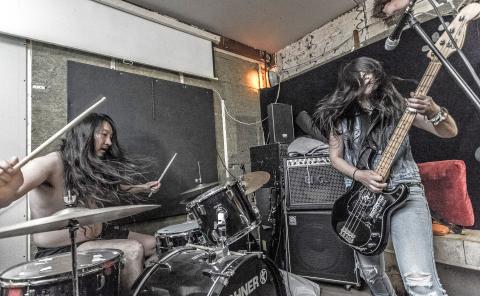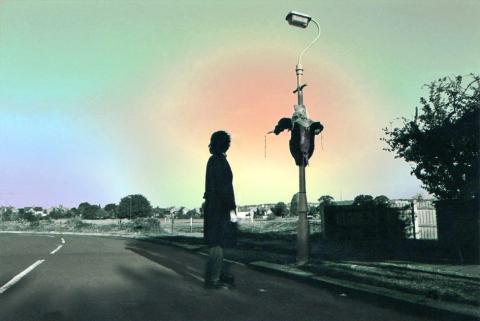The best music is filled with violence of the flesh and the soul. The incalculable beauty, the relative superfluity or value of song — all are more often than not determined by a troubled mind guiding a hand prone to vice.
That vice can be anger and violence itself. From Charles Mingus to Anton Newcombe to Eugene Robinson, the tempest has sometimes been self-inflicted. At others it has been brought on by a deliberate provocation courtesy of one of those addled souls who has been sucked into the swirl.
Violence attracts. It releases its practitioners and victims and willing participants from all social contracts. It liberates. It does what all great art sets out to do. And in the process, it naturally goes that it destroys all who allow themselves to be sucked in.

Photo courtesy of Sete Star Sept
The question becomes: how does one tap into the fathomless well without falling headlong into it?
For Japanese noise-grind duo Sete Star Sept, the key is focus. Taking the rage of grindcore, the misanthropy of harsh noise and the heady possibilities of free jazz and funneling the ensuing maelstrom wholly into the music.
Over the past six years, bassist Kae Takahashi and drummer Ryosuke Kiyasu, have disgorged a veritable landslide of split tapes, EPs, full-lengths, live recordings, MCDs, LPs — every medium past and present short of the eight-track. In touring and recording around the world several times over, the pair has never lost hold of the beast they tap into.

Photo courtesy of Yearning Kru
In their stage performance the violence and danger flows from and around them as the show inevitably devolves into Takahashi writhing on the floor, screaming into a wall of feedback, Kiyasu dissembling his kit down to the snare, sitting bow-legged on the ground, beating the already battered skin like a child’s toy.
Like most violent displays, the audience is left braying for more. Like any good art, it also leaves people with questions.
What in the hell did I just watch? Was it calculated? Improvised?
“Both,” answers Kiyasu in an interview with the Taipei Times. “Basically all the songs are structured. However, there are improvisational parts in each song.”
In the course of the band’s extensive touring (they seem to spend several months of the year on the road, returning to Tokyo to work part-time jobs between sojourns), Sete Star Sept has played everywhere from punk squats to traditional venues and, along the way, many places where music of an extreme nature might seem out of place, such as when they played Regensburg, Germany in the summer of 2013.
“The venue was kind of a stylish and upscale restaurant,” Kiyasu recalls. “There was nothing! No drum set. No bass guitar. No backline. There was even no microphone. The organizer had some troubles to get backline and musical gear. Kae sang a song a cappella without bass guitar and I played a snare drum on the ground.”
Sete Star Sept is currently touring Asia yet again. In September they’ll head back to Europe and are working on playing in such disparate locations as Mexico and Africa. When your music has no limitations and an endless well of chaotic inspiration from which to draw, the list of potential places to play becomes proportionally vast. The world over, violence attracts.
As Kiyasu puts it, Sete Star Sept is, “Destroying musical notes by intense energy.” Violence in action, one city, one country, one musical cynosure at a time.
■ Sete Star Sept headlines Argh Vol 4 tonight at Revolver, 1-2 Roosevelt Rd Sec 1, Taipei City (台北市羅斯福路一段1-2號). Tickets are NT$300 at the door with a drink, and the show gets started at 8:30pm
■ Tomorrow, Kiyasu will play a solo snare show at Lacking Sound Festival #101 at Changee (噪咖), 180, Fuhua Rd, Taipei City, (台北市福華路180號). Tickets are NT$250 at the door and the show begins at 7pm
■ On Sunday, Sete Star Sept reconvenes in Taoyuan at Vulgar Space (低俗空間), 255, Datong Rd, Taoyuan City (桃園市大同路255號). Tickets are NT$200 at the door and the show starts at 4pm
From the madcap precision and bombastic excess of noise to a festival celebrating all facets of pulsating electro-glitch and lo-fi psychedelia. Future Proof Sound Fest (聲響驗證未來) has evolved and thrived through five previous incarnations, with the sixth installment coming this weekend.
This time around, curators Phin Berry, of the currently on indefinite hiatus Dronetonics and recently activated new project Colour Domes Cam Scherman and Chung Po-hsun (鐘柏勳), known to most simply as “Mad,” have assembled an eclectic group of musicians for an afternoon and evening of electronic explorations.
Headlining the event is Croydon sound and visual artist Yearning Kru, who pieces together digital soundscapes and samples along with tripped out visual montages, all inspired by the literary world and building on the likes of Frank Herbert and Mervyn Peake.
Other highlights of the bill include the aforementioned Colour Domes, aptly described by Berry himself as “Nostalgic pop-ish songs braised in menace,” experimental synth duo (and Lonely God Records artists) Lu & Du, and D.R., precisely one half of EAOW (藝藥), another act plucked from the Lonely God roster which recently released their debut EP, 1st Kommt.
It should be a day of music that can only be described as post-everything, wallowing in the primordial essence of the weird and wonderful resurgence of sounds non-traditional here in Taiwan, assembled by those precocious minds, both violent and gentle, mildly psychotic and beautifully bent, from at home and abroad.
■ Future Proof Sound Fest (聲響驗證未來) Vol 6, tomorrow at Miculture Foundation Tiger Mountain (微遠虎山), 186-1, Ln 221, Fude St, Taipei City (台北市福德街221巷186-1號). Tickets are NT$300 at the door, and the event gets underway at 2pm

In Taiwan there are two economies: the shiny high tech export economy epitomized by Taiwan Semiconductor Manufacturing Co (TSMC, 台積電) and its outsized effect on global supply chains, and the domestic economy, driven by construction and powered by flows of gravel, sand and government contracts. The latter supports the former: we can have an economy without TSMC, but we can’t have one without construction. The labor shortage has heavily impacted public construction in Taiwan. For example, the first phase of the MRT Wanda Line in Taipei, originally slated for next year, has been pushed back to 2027. The government

July 22 to July 28 The Love River’s (愛河) four-decade run as the host of Kaohsiung’s annual dragon boat races came to an abrupt end in 1971 — the once pristine waterway had become too polluted. The 1970 event was infamous for the putrid stench permeating the air, exacerbated by contestants splashing water and sludge onto the shore and even the onlookers. The relocation of the festivities officially marked the “death” of the river, whose condition had rapidly deteriorated during the previous decade. The myriad factories upstream were only partly to blame; as Kaohsiung’s population boomed in the 1960s, all household

Allegations of corruption against three heavyweight politicians from the three major parties are big in the news now. On Wednesday, prosecutors indicted Hsinchu County Commissioner Yang Wen-ke (楊文科) of the Chinese Nationalist Party (KMT), a judgment is expected this week in the case involving Hsinchu Mayor Ann Kao (高虹安) of the Taiwan People’s Party (TPP) and former deputy premier and Taoyuan Mayor Cheng Wen-tsan (鄭文燦) of the Democratic Progressive Party (DPP) is being held incommunicado in prison. Unlike the other two cases, Cheng’s case has generated considerable speculation, rumors, suspicions and conspiracy theories from both the pan-blue and pan-green camps.

Stepping inside Waley Art (水谷藝術) in Taipei’s historic Wanhua District (萬華區) one leaves the motorcycle growl and air-conditioner purr of the street and enters a very different sonic realm. Speakers hiss, machines whir and objects chime from all five floors of the shophouse-turned- contemporary art gallery (including the basement). “It’s a bit of a metaphor, the stacking of gallery floors is like the layering of sounds,” observes Australian conceptual artist Samuel Beilby, whose audio installation HZ & Machinic Paragenesis occupies the ground floor of the gallery space. He’s not wrong. Put ‘em in a Box (我們把它都裝在一個盒子裡), which runs until Aug. 18, invites